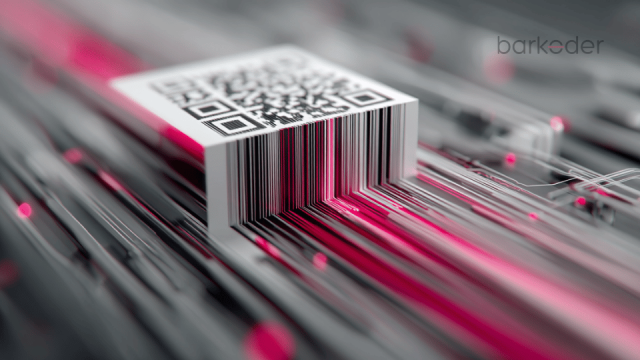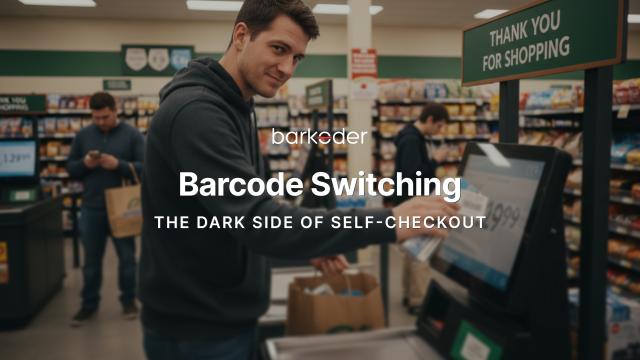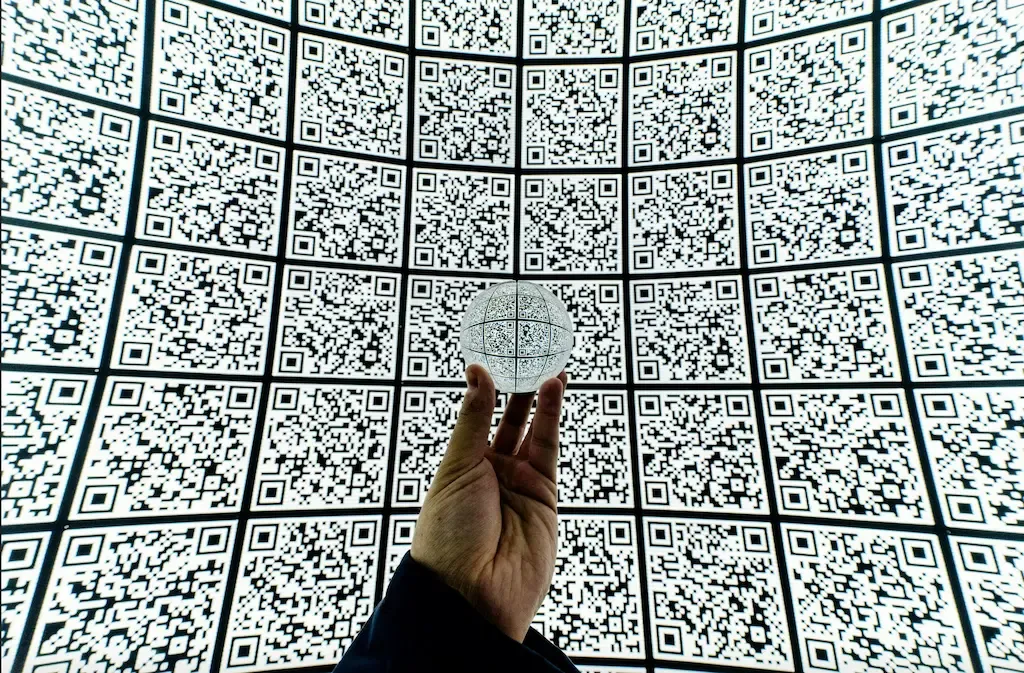
QR-code scanning on smartphones in 2019 and 2020, along with forecasts through 2025
What is a QR Code & what are its specifications
QR Codes were invented in 1994 by Denso-Wave in Japan to support the automobile manufacturing industry. Despite its trademark, the format is open, which allows royalty-free use of the symbology. Today, QR Codes are still widely used in Japan for many applications including encoding URLs in signs and publications.
Named QR for ‘Quick Response’ QR Codes are square codes that can be quickly read due to their design. QR Codes are square symbols, containing three distinctive ‘finder’ squares embedded in three corners of the symbol. A fourth smaller alignment square is near the lower right corner of the symbol. When read by a QR-enabled reader linked to a browser, the code can direct a user to a web site. The QR code also has a variant symbology known as the Micro QR Code, which can hold 35 characters in a small space.
Using a Free Barcode Generator online, you can easily convert data into a smartphone-scannable code for instant access and easy information sharing.
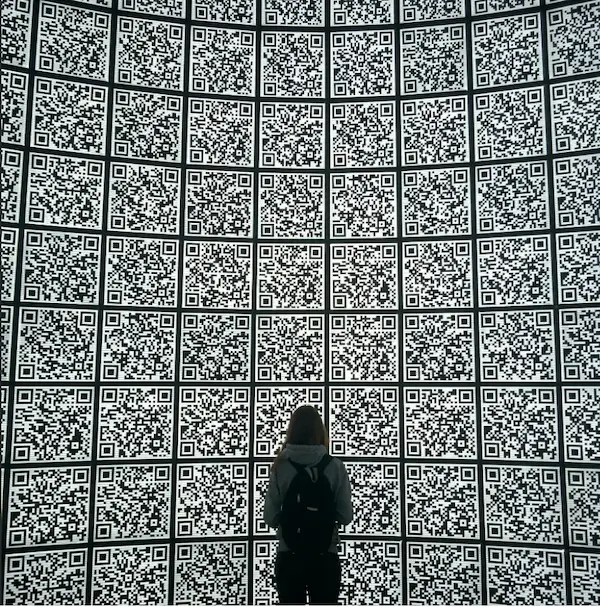
QR Code usage in the US
In 2019, around 47 million U.S. smartphone users scanned QR codes, with usage growing due to increased adoption in payments, retail, and marketing. In 2020, as COVID-19 encouraged contactless interactions, QR code usage surged to around 75 million users.
According to Statista’s projections, Forecasts from 2021 to 2025 show a continued increase in QR code use, especially for payments, driven by the growth of mobile payment platforms and the convenience of contactless technology. Here’s an approximate forecasted trajectory:
- 2021: 83 million users
- 2022: 90 million users
- 2023: 95 million users
- 2024: 98 million users
- 2025: 100 million users
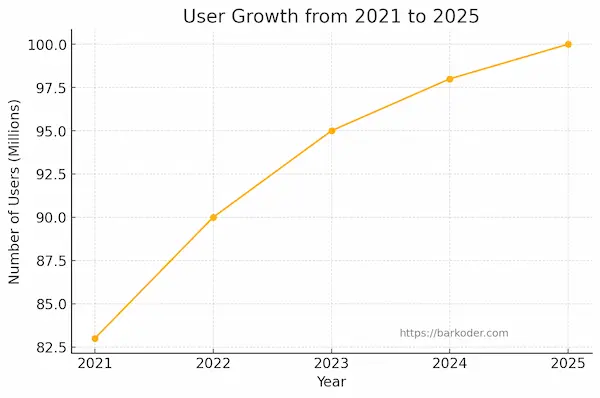
These estimates reflect increased integration of QR codes in retail, food service, and payment systems, with digital wallets and mobile banking apps also encouraging QR code adoption.
According to a similar report from Statista, approximately 37% of respondents expressed their willingness to scan a QR Code for payment, particularly in restaurants or bars.
The use of QR codes once limited to niche applications, has rapidly gained popularity in the U.S., especially over the last few years. From checking restaurant menus to seamless in-store payments, QR codes have transformed how we interact with everyday services. This trend is largely driven by the surge in smartphone penetration, advancements in mobile payment technology, and the post-COVID demand for contactless experiences. Let’s look at QR code usage statistics in 2019 and 2020, and then delve into future forecasts from 2020 to 2025.
QR Code Usage in 2019: Slow and Steady Beginnings
In 2019, around 47 million smartphone users in the United States scanned QR codes across various platforms and services. At this point, QR codes were primarily used for non-payment-related activities, like accessing restaurant menus, scanning product information in stores, and engaging in marketing promotions. Retail and entertainment sectors had begun adopting QR codes to some extent, but many people still saw them as an alternative, rather than a primary, form of interaction. Additionally, the use of QR codes for payments was still considered rare, with a greater focus on traditional credit card transactions and point-of-sale (POS) systems.
The Future of QR Code Usage in the U.S. (2020–2025)
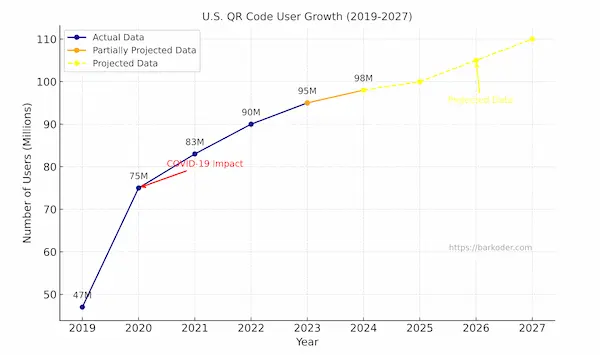
2020: A Surge in Adoption Due to COVID-19
In 2020, the world witnessed a significant shift in consumer behavior driven by the COVID-19 pandemic. Contactless interactions became critical for health and safety, which led to QR codes becoming mainstream for everything from touch-free menus to socially distanced payments. By the end of 2020, the number of U.S. smartphone users who scanned QR codes soared to approximately 75 million, marking a nearly 60% increase over the previous year.
This growth was largely spurred by the hospitality and retail industries, which swiftly adopted QR codes as a contact-free alternative to printed materials and shared devices. Even sectors like healthcare started leveraging QR codes for patient information and check-ins. The use of digital wallets and mobile banking apps also facilitated QR-based payment systems, reinforcing QR codes as a quick, convenient, and hygienic option.
2021: Continued Adoption and Mobile Payments Growth
In 2021 a survey revealed that 45% of U.S. shoppers had used a marketing-related QR code in the preceding three months. The highest usage was among individuals aged 18 to 29. QR code scanning reached approximately 83 million U.S. users.
This growth reflects increased familiarity and comfort with QR codes among consumers. Many retail chains, restaurants, and transportation services have embedded QR code options as a core part of their offerings, allowing users to make payments or check product information without physical interaction.
Mobile payment platforms like Apple Pay, Google Pay, and Venmo, which integrated QR codes, further drove adoption. The technology began to shift from simply a response to the pandemic to a new standard for digital interactions.
2022–2025: Continued Expansion and New Use Cases
Looking forward, QR code usage is expected to keep growing steadily, albeit at a slower pace than the initial surge:
- 2022: Around 90 million users are projected to scan QR codes on their smartphones.
- 2023: Estimates suggest QR code usage will reach 95 million users as businesses and public services continue to adopt and expand QR-based solutions.
- 2024: Usage is projected to grow further, hitting around 98 million users, as digital wallets and mobile banking platforms encourage QR-based payments. Additionally, this growth will be supported by new applications, such as event check-ins, transport ticketing, and social media sharing.
- 2025: By this year, 100 million U.S. smartphone users are expected to scan QR codes. As the technology becomes even more embedded in e-commerce, mobile payments, and service-based industries, QR codes are likely to evolve with added layers of security and integration with augmented reality (AR).
Key Drivers of QR Code Growth
- Consumer Demand for Contactless Experiences: The pandemic has made contactless transactions a lasting preference, even as in-person activities resumed.
- Expansion of Mobile Wallets and Digital Payments: QR codes are being used for digital wallets, facilitating both convenience and security in payment processes.
- Retail and Service Sector Integration: Many stores and restaurants have incorporated QR codes for everything from payments to loyalty programs.
- Enhanced Security and Versatility: With added encryption and fraud prevention mechanisms, QR codes have become safer, which makes them more appealing for sensitive transactions.
- New Use Cases and Innovations: The combination of QR codes with emerging technologies like AR and AI could lead to more personalized and interactive experiences, such as virtual try-ons and immersive product displays.
QR code users by demographic profile
Even though men like to think that only women do the shopping, global consumer spending seems to be evenly distributed among the sexes. In the United States, however, women are directly or indirectly responsible for up to $14.0 trillion or 80% of consumer spending.
- Research indicates that on a typical day, approximately 39.4% of American women and 33.7% of men engage in shopping activities.
- Financial data reveals that in a one-month period, the average single American male consumer allocates $3,608, equivalent to 98.6% of his post-tax income, towards expenditures. Comparatively, the average single female expends $3,515 monthly, representing 114.7% of her post-tax income.
- As mentioned, in a households with a spouse or partner present, mothers are responsible for 80% of grocery shopping tasks.
- On a global scale, women contribute nearly $35 trillion to consumer goods spending, accounting for 50% of worldwide consumer expenditures.
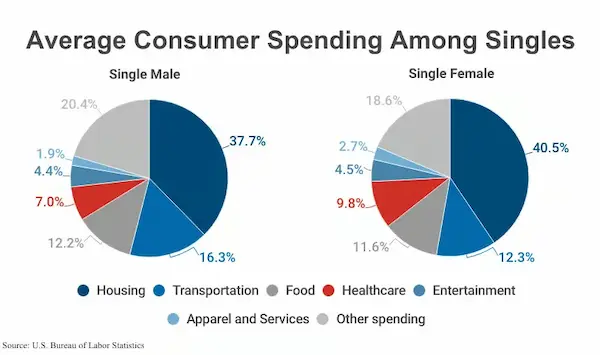
QR code usage statistics by gender are limited. However, some data hints at higher female engagement, especially in shopping and marketing. A Mobio Identity Systems, Inc. study found that women, often household decision-makers, performed about two-thirds of QR code scans. They used QR codes to get product details, join contests, and make mobile purchases.
When asked about gender, the poll takers have responded with 43% of QR users as male and 57% as female. This fact needs to be taken into account for a better consumer experience and it's important to take note of this gender gap when implementing QR code technology.

Among US-based participants, most QR code users were between the ages of 18 and 46, with the largest proportion being between the ages of 33 and 46. The largest group of non-QR code users was aged between 62 and 75, representing close to 40% of all non-users.
Taking a look at the statistics provided below, you will see that QR Code usage is highly correlated with age.

Interestingly, a study found a correlation between household income, smartphone choices, and QR code technology. In a 2021 survey, it turns out that those who use QR codes often earn between $30,000 and $80,000 annually. Surprisingly, many high earners, making over $100,000 annually, don’t use QR codes much.
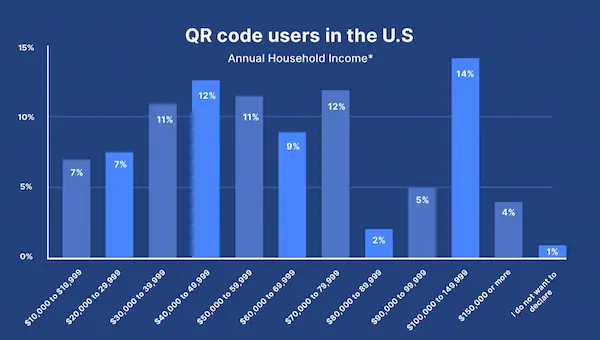
Worldwide QR Code Statistics
In 2014, Adobe Systems conducted a three-month study on QR Code usage across four countries: Germany, France, the UK, and the US. Of the total participants from Germany, a good 29% had used a QR Code. This number was 28% for France and 26% for the UK and the US.
Later, in 2019, the Global Web Index also conducted a study. This study showed the global percentage of QR Code users. They were as follows:
- 8% in North America
- 13% in Latin America
- 15% in the Asia Pacific
- 10% in Europe and Middle East Asia
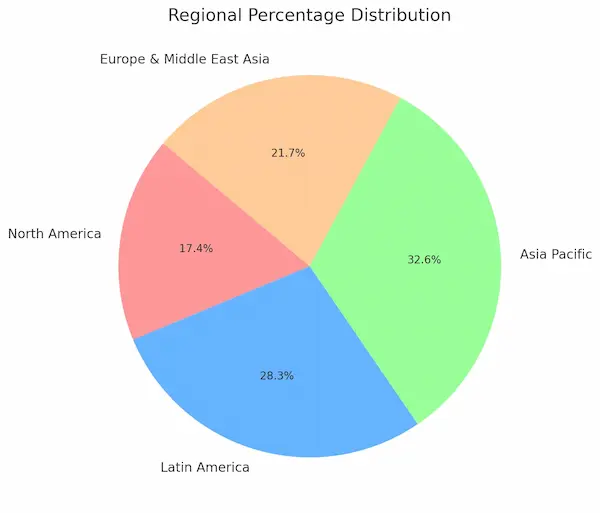
According to Bitly's 2023 report, QR code adoption has seen significant year-over-year growth across multiple countries. Leading the list are the United Kingdom, Switzerland, and the United States, where QR code creation surged as businesses and consumers increasingly embraced this technology. Close behind, Germany and France also reported strong growth in QR code adoption, driven by widespread use in retail, marketing, and service industries.
One standout in the report is Ukraine, which recorded an extraordinary increase, with QR code usage expanding by 14 times over the previous year. This impressive surge highlights a rapid digital transformation in the region, as more sectors integrate QR codes into their operations for enhanced accessibility and convenience.
QR Code usage in Russia
In September 2020, Statista conducted a similar survey with Russian participants. It was to gauge their support for various measures to tackle the coronavirus. According to the survey, 64% supported the introduction of the system with passes, QR Codes, and other similar movements within the system.
Interestingly, payments were the most frequent QR Code use case in 2021 in apparel stores. It made up 27% of the total share. Furthermore, about 8% of all QR Code payments happened at insurance companies.
These numbers indicate that people are now more aware of QR Codes than ever. Not only that, but they’re also willing to use them for day-to-day activities. This clearly indicates that the Russians have not only become more receptive to QR Codes but are supporting them too. This opens the door to adopting QR codes for various use cases nationwide.
QR Codes in Europe
QR code usage in Europe has seen substantial growth over recent years, driven by convenience and the demand for contactless interactions in sectors such as retail, food service, and transportation. By 2023, nearly 82% of the European population was familiar with QR codes, with over 40% scanning them at least weekly. The demand surged especially during the COVID-19 pandemic, transforming QR codes into an everyday tool for activities like accessing restaurant menus, making payments, and sharing product information.
Among European countries, the UK, Spain, and Italy have led in QR code adoption. In the UK, QR codes are widely used for payment solutions and fundraising, while in Spain, QR codes support both public and private sector initiatives. Italian businesses, particularly in agribusiness, use QR codes to engage consumers and enhance brand transparency by sharing product origins and values digitally.
The growing familiarity and ease of use have made QR codes an essential part of daily life in Europe, from enhancing shopping experiences to simplifying public transport navigation and even supporting health and educational initiatives. This widespread adoption underscores a strong trend toward more contactless, efficient digital interactions across the continent.
According to recent data from Statista, QR codes have become increasingly popular, with 90% of survey participants reporting QR code usage within the past month. Furthermore, 69% of respondents expressed willingness to use QR codes for payments in the future, signaling that QR code payments are gaining strong momentum as a mainstream payment method post-pandemic.
A total of 47.68% of QR codes are URLs.
When you scan a QR code and it shows you a URL or redirects you to a webpage, you've used a QR-based URL solution. As a result, QR codes are becoming increasingly popular because they eliminate the need to type a URL or search for it. Businesses benefit from QR codes because they save time, effort, and money.Customers can scan the menus of some restaurants and check them out using URLs. As a result, the restaurant saves money by not having to print their menus
Based on QR TIGER's reports, here are the ten most widely used QR code solutions:
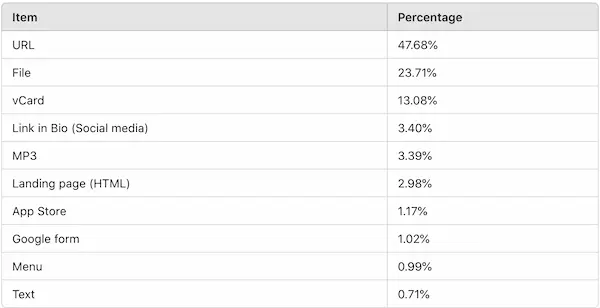
* Statistics in this blog are sourced from Statista, QR Tiger, Bitly's 2023 report, and the Global Web Index.
Looking Ahead: A Future with QR Codes
QR codes have firmly established their role in the digital landscape, from a pandemic-driven necessity to a convenient everyday tool. As we look towards 2025, the potential for QR codes continues to expand. Integrating with emerging technologies, QR codes are set to provide more personalized, secure, and convenient interactions across industries, making them an essential part of the mobile-first world.
As a final note, let's leave you with this pretty good showcase of the QR code technology made by @Veritasium.





